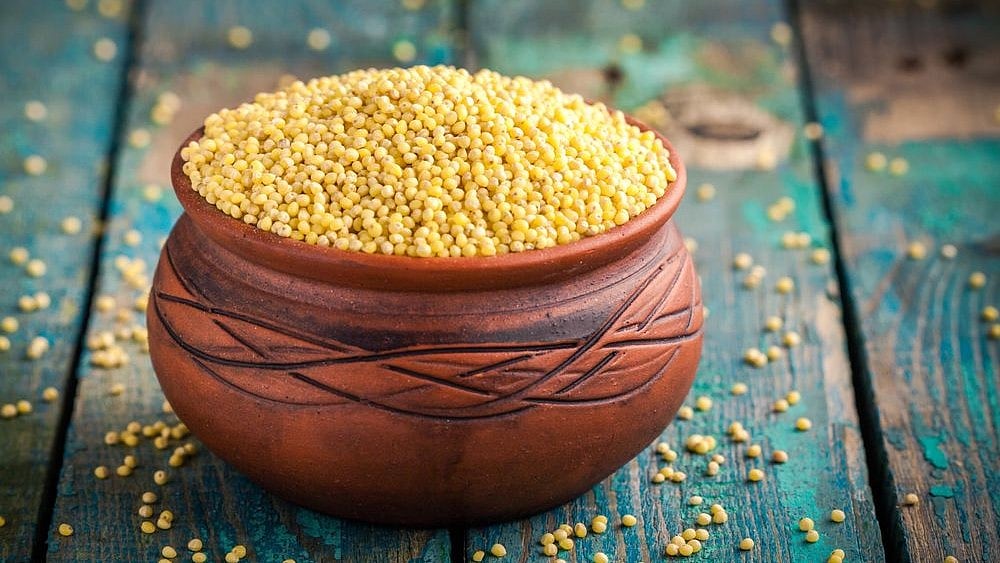India’s Millets: Untapped Global Export Market Poised For Growth | Representational Image
The United Nations declared 2023 as the International Year of Millets. We witnessed a lot of promotional work during the year. Some corporates launched branded food products with millet as the main ingredient.
Unfortunately, the positive noise about millets substantially died down the following year. We do not hear much about millets these days despite the position that India is the world’s largest producer of a variety of millets.
It devolves on our country and our policymakers to promote millets as ‘superfood’, as they are nutritious and can play a significant role in advancing our nutrition security. It is known that our nutrition status leaves much to be desired.
Millet promotion needs an ecosystem approach, which involves a comprehensive or holistic approach to identify challenges and deliver end-to-end solutions – from input sourcing, cultivation, marketing, and processing to final consumption.
Millets lend themselves to multiple applications and uses. They are food, feed, forage, fuel and ferment. Not many crops lend themselves to such varied utility. A market exists for each one of the applications.
It is for this reason that millets deserve sustained policy support, research support and investment support.
It is critical that the production growth and the consumption growth move in tandem or in lockstep. Millet production should be substantially demand-driven, so the benefits of a growing market flow to growers in good measure.
Because millets have multiple uses, it is important to engage with stakeholders in each of these segments.
First, we have to recognise the interrelationship between agriculture, food, nutrition and health. For growers, food is a source of livelihood and income; for consumers, food is a source of nutrition and health; for the processing industry, food crops are raw material.
It is important to promote the health benefits of millets among consumers. Make people aware of the wholesomeness of millets. Can we make millet consumption ‘fashionable’ for the growing middle class?
Renewed health consciousness among people now (especially after the COVID-19 pandemic) provides an opportune context. Corporates that market millet-based products can reach out to urban-literate middle class consumers.
At the same time, vulnerable sections of the population that actually suffer undernutrition deserve to consume more millets in partial replacement of fine cereals, rice and wheat. For the purpose, there have to be differentiated communication strategies for different sections of consumers.
Culinary trials will show that millet-based foods can be cooked easily and foods made therefrom are not only nutritious but also palatable or tasty. There’s an opportunity to explore ready-to-eat or ready-to-cook millet-based food products with a decent shelf life.
Again, there is a market for millet-based food or snacks for every age group and every category of consumers: Food for kids, for teenagers, for working women, for the elderly (geriatric food), for sportspersons (energy bars or protein bars), during convalescence; and so on.
Engagement with growers, especially Farmer Producer Organisations (FPOs), is critical. It is necessary to:
– Understand production issues: input availability, quality, cost, and agronomy
– Engage with input suppliers (seeds, fertilisers, agro-chemicals, banks)
– Link FPOs with millet processing companies to ensure easy marketability
– Encourage corporates towards ‘contract farming’ with FPO collaboration
Let us follow a four-point approach to boost millets. Growers may need stewardship. Agricultural universities and Krishi Vigyan Kendras must be roped in to collaborate with FPOs to provide guidance.
Technology infusion is key to boosting production and to ensuring an efficient supply chain. Today, multiple technologies are available, such as information and communication technology, agri-biotechnology, satellite technology, nuclear agricultural technology, nanotechnology, drones, field robotics, digitisation, and so on.
It would be rewarding to study the causes of high yields and low yields. Replicating the practices of high-yield areas in low-yield areas will lift overall national yields.
Last, but not the least, corporates in the millet user industry should be encouraged to establish backward linkages through the system of ‘contract farming’, which can help assure supplies of requisite quality and quantity.
Simultaneously, we have to look at the demand side. Food habits slowly evolve over time; but we can accelerate with promotion. Why not start with schoolchildren? Serving millet-based food under the Midday Meal Scheme will help. Other activities include cookery competitions; group discussions by homemakers; celebrity chefs; engagement with catering colleges and so on.
It is equally important to engage with millet processing companies to understand their challenges—raw material (millet) availability, quality, price, and so on.
Lastly, we must encourage start-ups, work with food tech or food research institutions (like CFTRI), and create a research-industry interface to produce nutritionally rich, ready-to-eat, economically priced millet-based snacks or food for mass consumption. Organic millets are another area. There is an export market waiting to be tapped.
G. Chandrashekhar is an economist, senior journalist and policy commentator. He is also an agribusiness specialist with global exposure. He serves on corporate boards as Independent Director. Views are personal.
